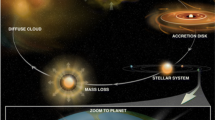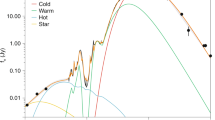Abstract
The Single Aperture Far-InfraRed (SAFIR) Observatory’s science goals are driven by the fact that the earliest stages of almost all phenomena in the universe are shrouded in absorption by and emission from cool dust and gas that emits strongly in the far-infrared (40μ–200μ) and submillimeter (200μ–1 mm). In the very early universe, the warm gas of newly collapsing, unenriched galaxies will be revealed by molecular hydrogen emission lines at these long wavelengths. High redshift quasars are found to have substantial reservoirs of cool gas and dust, indicative of substantial metal enrichment early in the history of the universe. As a result, even early stages of galaxy formation will show powerful far-infrared emission. The combination of strong dust emission and large redshift (1 < z < 7) of these galaxies means that they can only be studied in the far-infrared and submillimeter. For nearby galaxies, many of the most active galaxies in the universe appear to be those whose gaseous disks are interacting in violent collisions. The details of these galaxies, including the effect of the central black holes that probably exist in most of them, are obscured to shorter wavelength optical and ultraviolet observatories by the large amounts of dust in their interstellar media. Within our own galaxy, the earliest stages of star formation, when gas and dust clouds are collapsing and the beginnings of a central star are taking shape, can only be observed in the far-infrared and submillimeter. The cold dust that ultimately forms the planetary systems, as well as the cool “debris” dust clouds that indicate the likelihood of planetary sized bodies around more developed stars, can only be observed at wavelengths longward of 20μ.
Over the past several years, there has been an increasing recognition of the critical importance of the far-infrared to submillimeter spectral region to addressing fundamental astrophysical problems, ranging from cosmological questions to understanding how our own Solar System came into being. The development of large, far-infrared telescopes in space has become more feasible with the combination of developments for the James Webb Space Telescope (JWST) of enabling breakthroughs in detector technology.
We have developed a preliminary but comprehensive mission concept for SAFIR, as a 10 m-class far-infrared and submillimeter observatory that would begin development later in this decade to meet the needs outlined above. Its operating temperature (≤4 K) and instrument complement would be optimized to reach the natural sky confusion limit in the far-infrared with diffraction-limited performance down to at least the atmospheric cutoff, λ {>rsim} 40 {μ}. This would provide a point source sensitivity improvement of several orders of magnitude over that of the Spitzer Space Telescope (previously SIRTF) or the Herschel Space Observatory. Additionally, it would have an angular resolution 12 times finer than that of Spitzer and three times finer than Herschel. This sensitivity and angular resolution are necessary to perform imaging and spectroscopic studies of individual galaxies in the early universe. We have considered many aspects of the SAFIR mission, including the telescope technology (optical design, materials, and packaging), detector needs and technologies, cooling method and required technology developments, attitude and pointing, power systems, launch vehicle, and mission operations. The most challenging requirements for this mission are operating temperature and aperture size of the telescope, and the development of detector arrays. SAFIR can take advantage of much of the technology under development for JWST, but with much less stringent requirements on optical accuracy.
Similar content being viewed by others
References
A Strawman Verification, Integration and Test Program For NGST, NGST Monograph No. 4, 2000.
Amato, M.J., Benford, D.J., Moseley, S.H. and Roman, J.: 2003, An Engineering Concept and Enabling Technologies for a Large Single Aperture Far-IR Observatory (SAFIR), in: IR Space Telescopes and Instruments, Proceeding of SPIE 4850, 1120–1131.
Blain, A.W., Ivison, R.J. and Smail, I.: 1998, MNRAS 296, L29–L33.
Dipirro, M.: 2003, Cryogenic Technology: Ongoing Developments for the Next Decade, in: D.J. Benford and D.T. Leisawitz (eds.), New Concepts for Far-Infrared and Submillimeter Space Astronomy, NASA/CP212233.
Dowell, C.D. et al.: 2003, Proc. SPIE 4855, 73–87.
Dragovan, M.: 2002, Proc. SPIE 4849, 1–7.
Harvey, P.M., Rieke, G.H., Lester, D.F. and Benford, D.J.: 2003, Proc. SPIE 4850, 1097–1108.
Harwit, M.: 1981, Cosmic Discovery: The Search, Scope, and Heritage of Astronomy, Basic Books, New York.
Kooi, J.W., Kovacs, A., Kaye, S., Dama, J., Edgar, M.L., Zmuidzinas, J. and Phillips, T.G.: 2003, Proc. SPIE 4855, 265–278.
Looney, L.W. et al.: 2003, IR Space Telescopes and Instruments, Proc. SPIE 4857, 47–55.
National Academy of Sciences: 1991, The Decade of Discovery in Astronomy and Astrophysics, National Academy Press, Washington DC.
National Academy of Sciences: 2001, Astronomy and Astrophysics in the New Millennium, National Academy Press, Washington DC.
Richards, P.L.: 2003, Future Far-Infrared/Submillimeter Direct Detectors, in: D.J. Benford and D.T. Leisawitz (eds.), New Concepts for Far-Infrared and Submillimeter Space Astronomy, NASA/CP-212233, pp. 325–328.
Rieke, G.H. et al.: 2003, Charting the Winds that Change II: the Single Aperture Far-Infrared Observatory (SAFIR), in: D.J. Benford and D.T. Leisawitz (eds.), New Concepts for Far-Infrared and Submillimeter Space Astronomy, NASA/CP212233.
Shirron, P., Canavan, E., DiPirro, M., Jackson, M., King, T., Panek, J. and Tuttle, J.: 2002, Cryogenics 41, 11–12, 789–795.
The Community Plan for Far-Infrared and Submillimeter Space Astronomy: 2003, in: D.J. Benford and D.T. Leisawitz (eds.), New Concepts for Far-Infrared and Submillimeter Space Astronomy, NASA/CP212233.
Young, E.T., Rieke, G.H., Cadien, J., Dole, H.A., Englebracht, C.W., Gordon, K.D., Heim, G.B., Kelly, D.M. and Stansberry, J.A.: 2003, Proc. SPIE 4850, 98–107.
Author information
Authors and Affiliations
Corresponding author
Rights and permissions
About this article
Cite this article
Benford, D.J., Amato, M.J., Mather, J.C. et al. Mission Concept for the Single Aperture Far-Infrared (SAFIR) Observatory. Astrophys Space Sci 294, 177–212 (2004). https://doi.org/10.1007/s10509-004-5377-4
Received:
Accepted:
Issue Date:
DOI: https://doi.org/10.1007/s10509-004-5377-4




